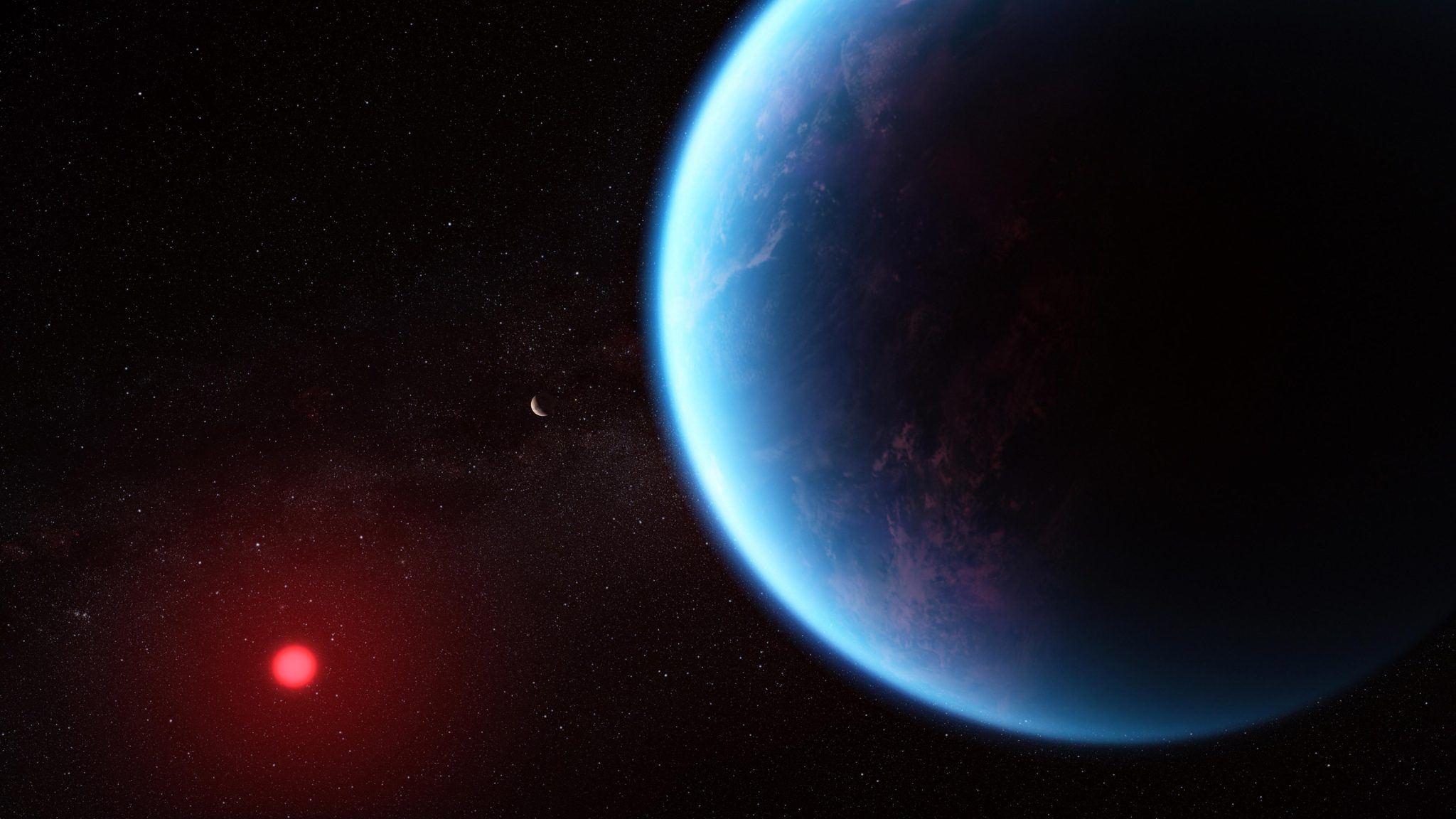
Posted on 09/12/2023 11:48:34 AM PDT by Red Badger

This artist’s concept shows what exoplanet K2-18 b could look like based on science data. K2-18 b, an exoplanet 8.6 times as massive as Earth, orbits the cool dwarf star K2-18 in the habitable zone and lies 120 light-years from Earth. A new investigation with NASA’s James Webb Space Telescope into K2-18 b has revealed the presence of carbon-bearing molecules including methane and carbon dioxide. The abundance of methane and carbon dioxide, and shortage of ammonia, support the hypothesis that there may be a water ocean underneath a hydrogen-rich atmosphere in K2-18 b. Credit: NASA, ESA, CSA, Joseph Olmsted (STScI), Nikku Madhusudhan (IoA)
Data hints at exoplanet possessing possible liquid ocean surface.
Carbon-bearing molecules have been discovered in the atmosphere of the habitable zone exoplanet K2-18 b by an international team of astronomers using data from NASA’s James Webb Space Telescope. These results are consistent with an exoplanet that may contain ocean-covered surface underneath a hydrogen-rich atmosphere. This discovery provides a fascinating glimpse into a planet unlike anything in our Solar System, and raises interesting prospects about potentially habitable worlds elsewhere in the Universe.

Spectra of K2-18 b, obtained with Webb’s NIRISS (Near-Infrared Imager and Slitless Spectrograph) and NIRSpec (Near-Infrared Spectrograph), display an abundance of methane and carbon dioxide in the exoplanet’s atmosphere, as well as a possible detection of a molecule called dimethyl sulfide (DMS). The detection of methane and carbon dioxide, and shortage of ammonia, support the hypothesis that there may be a water ocean underneath a hydrogen-rich atmosphere in K2-18 b. K2-18 b, 8.6 times as massive as Earth, orbits the cool dwarf star K2-18 in the habitable zone and lies 120 light-years from Earth. Credit: NASA, ESA, CSA, Ralf Crawford (STScI), Joseph Olmsted (STScI), Nikku Madhusudhan (IoA)
Webb Discovers Methane, Carbon Dioxide in Atmosphere of K2-18 b A new investigation with NASA’s James Webb Space Telescope into K2-18 b, an exoplanet 8.6 times as massive as Earth, has revealed the presence of carbon-bearing molecules including methane and carbon dioxide. Webb’s discovery adds to recent studies suggesting that K2-18 b could be a Hycean exoplanet, one which has the potential to possess a hydrogen-rich atmosphere and a water ocean-covered surface.
The first insight into the atmospheric properties of this habitable-zone exoplanet came from observations with NASA’s Hubble Space Telescope, which prompted further studies that have since changed our understanding of the system.
K2-18 b orbits the cool dwarf star K2-18 in the habitable zone and lies 120 light-years from Earth in the constellation Leo. Exoplanets such as K2-18 b, which have sizes between those of Earth and Neptune, are unlike anything in our solar system. This lack of equivalent nearby planets means that these ‘sub-Neptunes’ are poorly understood, and the nature of their atmospheres is a matter of active debate among astronomers.
Implications for Exoplanet Life
The suggestion that the sub-Neptune K2-18 b could be a Hycean exoplanet is intriguing, as some astronomers believe that these worlds are promising environments to search for evidence for life on exoplanets.
“Our findings underscore the importance of considering diverse habitable environments in the search for life elsewhere,” explained Nikku Madhusudhan, an astronomer at the University of Cambridge and lead author of the paper announcing these results. “Traditionally, the search for life on exoplanets has focused primarily on smaller rocky planets, but the larger Hycean worlds are significantly more conducive to atmospheric observations.”
The abundance of methane and carbon dioxide, and shortage of ammonia, support the hypothesis that there may be a water ocean underneath a hydrogen-rich atmosphere in K2-18 b. These initial Webb observations also provided a possible detection of a molecule called dimethyl sulfide (DMS). On Earth, this is only produced by life. The bulk of the DMS in Earth’s atmosphere is emitted from phytoplankton in marine environments.
The inference of DMS is less robust and requires further validation. “Upcoming Webb observations should be able to confirm if DMS is indeed present in the atmosphere of K2-18 b at significant levels,” explained Madhusudhan.
Characterizing Exoplanet Atmospheres
While K2-18 b lies in the habitable zone, and is now known to harbor carbon-bearing molecules, this does not necessarily mean that the planet can support life. The planet’s large size — with a radius 2.6 times the radius of Earth — means that the planet’s interior likely contains a large mantle of high-pressure ice, like Neptune, but with a thinner hydrogen-rich atmosphere and an ocean surface. Hycean worlds are predicted to have oceans of water. However, it is also possible that the ocean is too hot to be habitable or be liquid.
“Although this kind of planet does not exist in our solar system, sub-Neptunes are the most common type of planet known so far in the galaxy,” explained team member Subhajit Sarkar of Cardiff University. “We have obtained the most detailed spectrum of a habitable-zone sub-Neptune to date, and this allowed us to work out the molecules that exist in its atmosphere.”
Characterizing the atmospheres of exoplanets like K2-18 b — meaning identifying their gases and physical conditions — is a very active area in astronomy. However, these planets are outshone — literally — by the glare of their much larger parent stars, which makes exploring exoplanet atmospheres particularly challenging.
The team sidestepped this challenge by analyzing light from K2-18 b’s parent star as it passed through the exoplanet’s atmosphere. K2-18 b is a transiting exoplanet, meaning that we can detect a drop in brightness as it passes across the face of its host star. This is how the exoplanet was first discovered in 2015 with NASA’s K2 mission. This means that during transits a tiny fraction of starlight will pass through the exoplanet’s atmosphere before reaching telescopes like Webb. The starlight’s passage through the exoplanet atmosphere leaves traces that astronomers can piece together to determine the gases of the exoplanet’s atmosphere.
James Webb’s Capabilities and Future Research
“This result was only possible because of the extended wavelength range and unprecedented sensitivity of Webb, which enabled robust detection of spectral features with just two transits,” said Madhusudhan. “For comparison, one transit observation with Webb provided comparable precision to eight observations with Hubble conducted over a few years and in a relatively narrow wavelength range.”
“These results are the product of just two observations of K2-18 b, with many more on the way,” explained team member Savvas Constantinou of the University of Cambridge. “This means our work here is but an early demonstration of what Webb can observe in habitable-zone exoplanets.”
The team’s results were accepted for publication in The Astrophysical Journal Letters.
The team now intends to conduct follow-up research with the telescope’s MIRI (Mid-Infrared Instrument) spectrograph which they hope will further validate their findings and provide new insights into the environmental conditions on K2-18 b.
“Our ultimate goal is the identification of life on a habitable exoplanet, which would transform our understanding of our place in the universe,” concluded Madhusudhan. “Our findings are a promising step towards a deeper understanding of Hycean worlds in this quest.”
NASA’s James Webb Space Telescope is the world’s premier space science observatory. It is solving mysteries in our solar system, looking beyond to distant worlds around other stars, and probing the mysterious structures and origins of our universe and our place in it. Webb is an international program led by NASA with its partners, ESA (European Space Agency) and the Canadian Space Agency.
Exoplanet Ping!.................
God hasn’t looked here lately, took a look and thought ‘I’ve got to start over, it’s a wreck down there’.
“120 light-years from Earth...” at Warp factor 7, 686 times the speed of light it will only take us 67 days to get there...oh wait...
I’m struggling with this article. It states “8.6 times as massive as Earth”. Saturn is ~9x Earth, and Neptune is ~4X Earth, so I don’t understand why they call this one a sub-Neptune planet.
Which means this data is older than your grandmother
The writer is confusing mass with volume I think................
Ah - yeah I just caught the diameter reference of 2.5.
Neptune is 17 earth masses.
The usual tapdancing hype.

C-SPAN recently re-aired a scientific discussion from 1975 about the possibility of life elsewhere than on earth. It included some big name scientists like Carl Sagan and George Wald (Nobel Prize winner 1967) and a theologian. Most if not all thought that life must exist elsewhere.

Even if there is, we will never see it. Not any living human being will ever travel among the stars.
The ‘Speed of Light’ is not anywhere near fast enough and that is the limiting factor of space travel.
Neither is 10 times the Speed of Light, which is technically impossible to achieve.
When we become Spirit Beings, like God and the Angels, and can traverse the universe at the speed of thought, then we will see everything that’s out there.................
We now know there are lots of "exoplanets" out there and it may be that some have some kind of life--but perhaps only very primitive forms. The chances of intelligent life evolving somewhere else may be infinitesimal--but given the number of stars in the universe, there could be one or more elsewhere, maybe in another galaxy. So we are very unlikely ever to make contact (and it may be safer not to), but it is conceivable that we will find evidence of some kind of life elsewhere even if we can't actually visit it.
Somebody has to be ‘first’, why not us?.............😁
And exactly when can we go to this planet? Ah... That’s the rub. We can’t and never will. Oh well.
Dang! It looks SO easy.
Although not technically violating any known laws of physics, there might be a few minor engineering difficulties involved in building one. Elon Musk once said it would require several Jupiter masses of equivalent energy just to power it. That’s just one. There’s also pronouncing it.
Disclaimer: Opinions posted on Free Republic are those of the individual posters and do not necessarily represent the opinion of Free Republic or its management. All materials posted herein are protected by copyright law and the exemption for fair use of copyrighted works.